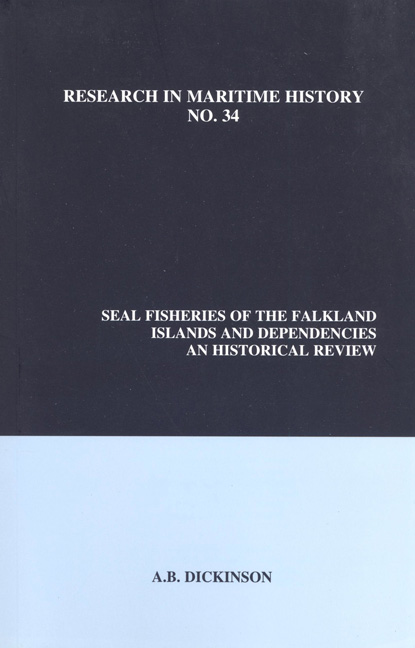Book contents
- Frontmatter
- map
- Contents
- List of Tables in the Text
- List of Illustrations
- About the Author
- Chapter 1 Introduction
- Chapter 2 Unregulated Sealing in the Falkland Islands
- Chapter 3 The Development of a Regulated Industry
- Chapter 4 Unregulated Sealing in the Dependencies
- Chapter 5 Regulated Sealing in the Falkland Islands, 1881-1914
- Chapter 6 Pelagic Sealing
- Chapter 7 Twentieth-Century Sealing on the Falkland Islands
- Chapter 8 Controlled Sealing at South Georgia
- Chapter 9 Aftermath
- Appendices 1-8
Chapter 3 - The Development of a Regulated Industry
- Frontmatter
- map
- Contents
- List of Tables in the Text
- List of Illustrations
- About the Author
- Chapter 1 Introduction
- Chapter 2 Unregulated Sealing in the Falkland Islands
- Chapter 3 The Development of a Regulated Industry
- Chapter 4 Unregulated Sealing in the Dependencies
- Chapter 5 Regulated Sealing in the Falkland Islands, 1881-1914
- Chapter 6 Pelagic Sealing
- Chapter 7 Twentieth-Century Sealing on the Falkland Islands
- Chapter 8 Controlled Sealing at South Georgia
- Chapter 9 Aftermath
- Appendices 1-8
Summary
In November 1820 the United Provinces de la Plata despatched Col. Daniel Jewitt to the Falkland Islands on the frigate Heroina to take “formal possession.” On arrival, he informed the crews of some fifty foreign sealing and whaling vessels that the laws of the United Provinces were now in effect and that they could not continue their activities; offenders would be sent to Buenos Aires for trial. Jewitt could not enforce his demands, however, since his vessel was in poor condition, and many of his crew had scurvy. As a result, General Knox (Capt. W.B. Orne) was able to return to Salem on 6 June 1821 with 5000 seal skins, 600 barrels of whale oil and a copy of Jewitt's letter, no doubt ignored, to inform those sealers about to depart for the islands. Although fur seals were now scarce, and the American fur trade to Canton had considerably diminished, the market for skins and oil was improving in the increasingly industrialized and populated US. At least thirty sealing voyages were therefore made from New England in 1820-1821, including to the Falkland Is lands. Auction records suggest that more than 167,000 fur seal skins were sold in America from 1824-1846, mainly in New York but also in Boston, Jersey City and Stonington. At least sixty-five percent were from mature females. Wholesale prices jumped from US $5 in 1830 to US $12 in 1835-1836.
Sealing was now dominated by the Americans. The number of British southern whaling and sealing vessels declined by half from 1820-1821 to 1824- 1825 as coal gas street lighting reduced the demand for marine mammal oil, and the need for skins to make “beaver” hats also fell as silk ones became fashionable. Hat exports to America slowed, in part following refinements in the domestic seal skin processing industry. The coarse guard hairs had initially been left on, and the caps sold to less fashion-conscious and impoverished blacks in the south. Guard hairs began to be removed around 1823, and skins were able to be dyed brown from 1825. Low wholesale prices for skins now meant that “beaver” hats were cheap to make and sell. Some of the skins probably came from the ever-decreasing numbers on the Falklands, since Woodbine Parish, the British representative in Buenos Aires, reported twentysix sealing vessels entering Puerto de la Soledad between June 1826 and March 1831 (see appendix 2).
- Type
- Chapter
- Information
- Seal Fisheries of the Falkland Islands and DependenciesAn Historical Review, pp. 43 - 60Publisher: Liverpool University PressPrint publication year: 2007



